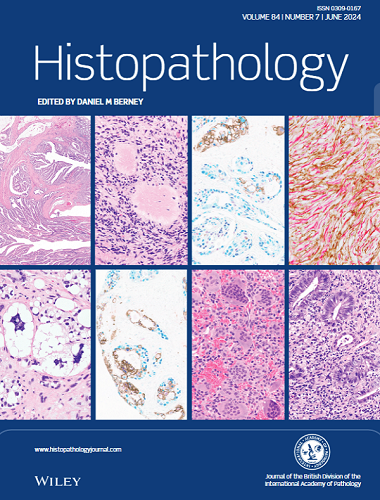Challenges of a tailored immunohistochemistry algorithm for uterine leiomyosarcoma: an integrated analysis of leiomyomas with bizarre nuclei and fumarate hydratase (FH) deficiency
Abstract
Aims
Leiomyomas (LM) are the most common uterine mesenchymal neoplasms and encompass a variety of histological subtypes. Bizarre nuclei are described in both leiomyomas with bizarre nuclei (LM-BN) and fumarate hydratase-deficient leiomyomas (FH-LM), which raise diagnostic concerns regarding leiomyosarcoma (LMS). Recently, an immunohistochemical algorithm to support the diagnosis of LMS based on the genomic landscape of these neoplasms was proposed. This study aimed to evaluate the algorithm's accuracy in distinguishing LM-BN and FH-LM from LMS.
Methods and Results
We collected 68 LM (29 LM-BN, 30 FH-LM, and 9 LM) and 9 LMS, along with clinicopathological and molecular data. An immunohistochemical panel comprising p53, Rb, PTEN, ATRX, DAXX, and MDM2 was applied. Nine cases were non-interpretable due to fixation issues. The algorithm demonstrated 100% accuracy for LM without bizarre nuclei (9/9) and for nonmyxoid LMS (5/5). Notably, 28.6% (14/49) of LM-BN and FH-LM exhibited at least two abnormalities, leading to potential misclassification as LMS. However, their clinical course, morphology, and genomic profile supported a benign diagnosis. Frequent alterations included Rb (20/49; 40.8%) and p53 (19/49; 38.8%), particularly in bizarre cells, while no abnormal staining was observed for ATRX, DAXX, or MDM2.
Conclusion
The proposed algorithm has limitations in differentiating LMS from LM-BN and FH-LM, misclassifying 28.6% of the latter. Accurate interpretation requires proper internal controls, particularly for markers whose loss of expression favours malignancy. Morphology remains central for diagnosis, although integration of molecular data may provide additional insights for a definitive classification in challenging cases.


 求助内容:
求助内容: 应助结果提醒方式:
应助结果提醒方式:


